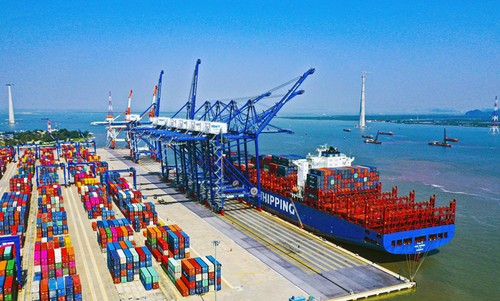 (Photo: moit.gov.vn) (Photo: moit.gov.vn) |
Vietnam earned over 262 billion USD from exports in the first 5 months of the year, down nearly 15%. Export turnover has fallen 11.6%. Most of Vietnam's export items declined due to the global economic recession, but should grow again from now until the end of the year. Export turnover in May was 29 billion USD, up 4.3%.
The domestic economic sector gained 7.79 billion USD, up 1%, and the foreign-invested sector, including crude oil, gained 21 billion USD, up 5.5%. Industrial products, especially electronic items, recovered their growth. Some agricultural exports turned high profits. Rice penetrated the EU’s demanding markets.
The balance of trade continued to show a surplus, said Tran Thanh Hai, Deputy Director of the Import-Export Department of the Ministry of Industry and Trade.
“We earned about 10 billion USD in trade surplus in the first 5 months. The figure will help us stabilize our foreign exchange balance. Fundamentally, the trade balance is at a stable level,” said Hai.
A number of Vietnamese agricultural products are in their main crop. The lychee harvest has already begun this month. Domestic businesses have promoted Luc Ngan lychees to Japan, Europe, and the US.
According to representatives of Vietnam Trade Offices abroad, import markets often set strict requirements on food safety, environment-friendliness, and gas emissions. Cao Xuan Thang, head of the Vietnam Trade Office in Singapore, called on functional agencies, associations, and businesses to strictly manage the production process from planting to harvest, so that agricultural products meet the standards for export quality.
“This is important because we are conducting promotion programs. If our products don’t meet the quality requirements, it will be difficult to penetrate foreign markets, especially in developed countries. Even after successfully entering those markets, businesses still have to pay close attention to product quality,” Thang added.
Seafood, one of Vietnam's key export products, earned nearly 3.5 billion USD in 5 months, down 26% from last year. That number is not too bad considering that last year Vietnam's seafood industry made a growth breakthrough of 11 billion USD.
To achieve the set target of 10 billion USD this year, Vietnam has diversified export markets and increased trade promotion on e-commerce platforms.

Le Hang, VASEP’s Communications Director (Photo: Uyen Huong/BNEWS/VNA)
|
Le Hang, Communications Director of the Vietnam Association of Seafood Exporters and Producers (VASEP), says free trade agreements have opened up new export opportunities and helped Vietnam take the initiative in raw material sources for production.
The seafood industry is trying to contribute more to the national export growth target this year, said Hang, adding that the biggest advantage is that Vietnam’s seafood sector has an alternative raw material supply when we experience a shortage of domestic supply. “That explains why Vietnam needs to import raw materials for production, export, and processing, and why re-export to the EU, the US, Japan, and South Korea has increased sharply in recent years,” said Hang.
Inflation in some markets has been decreasing, while the demand for imported goods is on the rise, offering an opportunity for Vietnam’s exports to recover in the coming months, said Hai.
“The current decline is mainly due to market issues, but the production capacity of domestic businesses remains strong despite the epidemic and the disruption of the raw material supply. This is a favorable factor to help Vietnamese enterprises be ready to resume production and export as soon as the market bounces back,” according to Hai.
Closer coordination between Vietnamese Trade Offices overseas and trade promotion agencies, ministries, and localities will help Vietnamese exporters adapt to market changes. This will help Vietnam’s exports reach the growth target of 6%, or about 394 billion USD, this year.